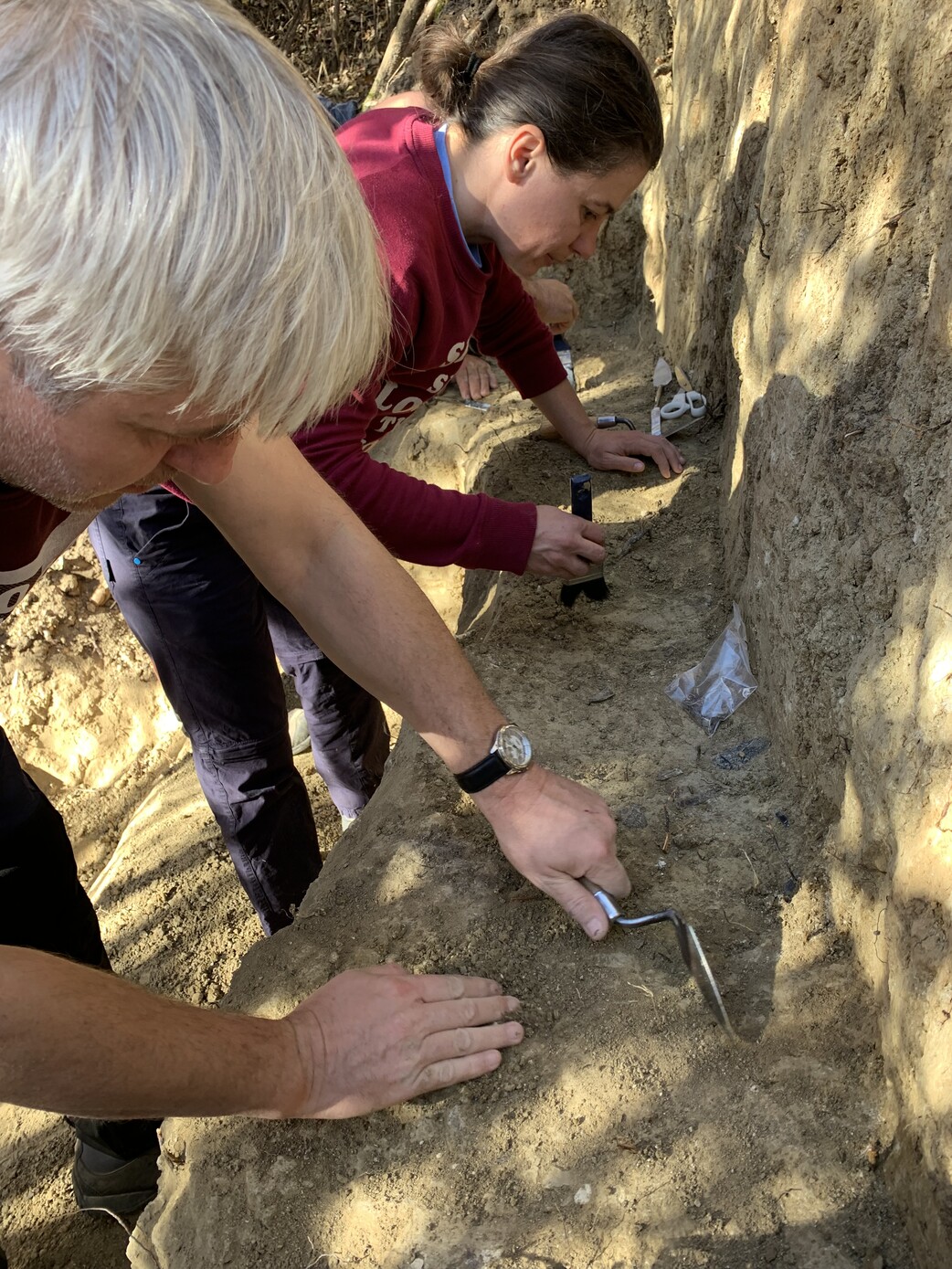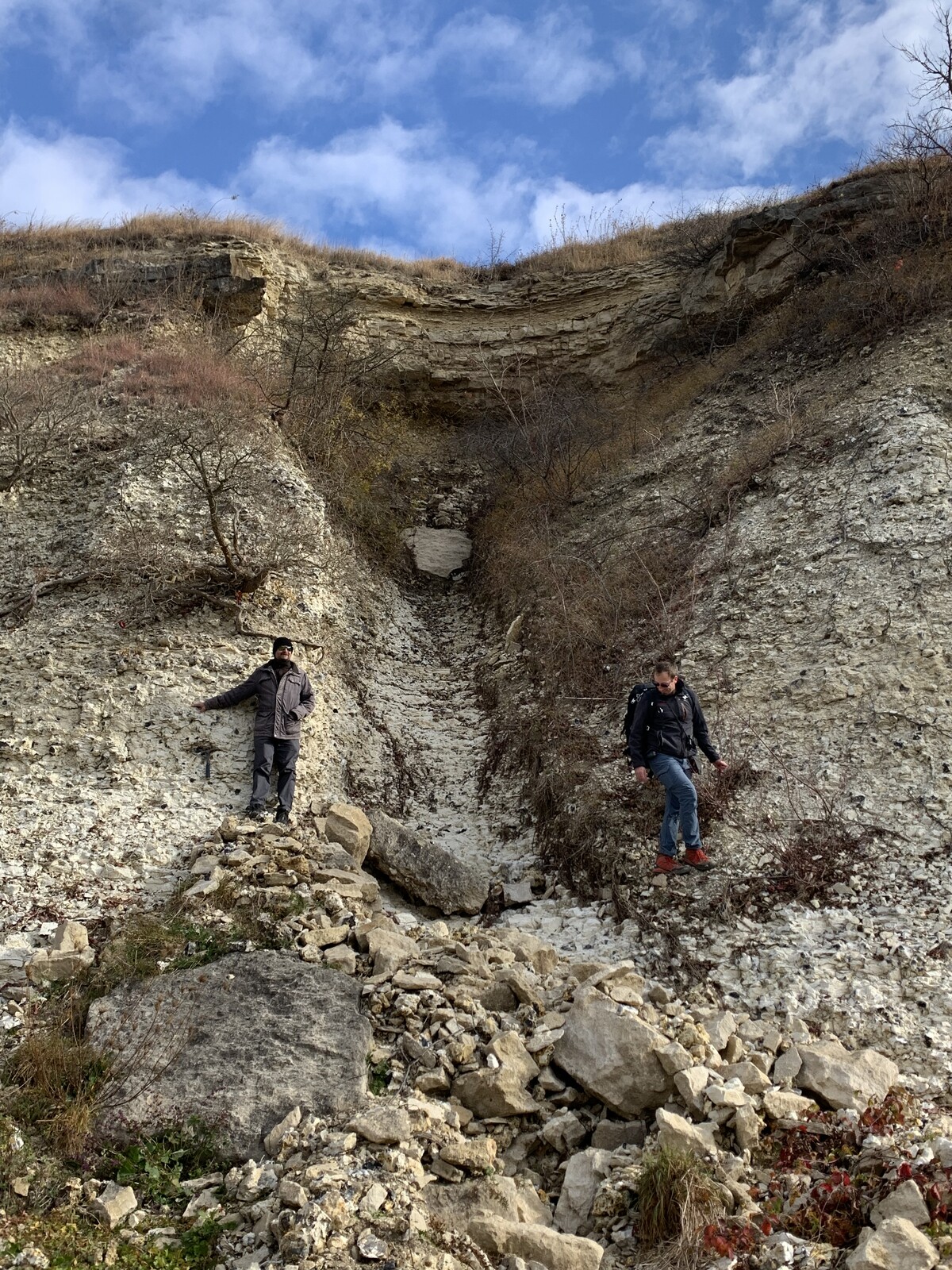Comparing Upper Palaeolithic sequences across the Carpathians
Project aim is a comparison of Upper Palaeolithic records and sediment archives of the Krems area in Northeast Austria and the Ceahlău Basin in the eastern Carpathians. At the current stage, data collection in the Ceahlău Basin and the Transcarpathian fore- and lowlands is intensified by fieldwork conducted jointly with the Valahia University of Târgoviste.

The appearance of Anatomically Modern Humans in Europe around 40,000 years ago coincided with highly dynamic environmental conditions during the latter part of the last glacial cycle which ended with the begin of the Holocene 11,700 years ago. For the Upper Palaeolithic record, these conditions led to complex patterns of preservation on all levels − for finds, structures, and sites. Preferably, the archaeological record is embedded in a sequence of naturally deposited sediments allowing for assessment of the environmental context and chrono-stratigraphic placement.
Project Goals
The project aims at comparing the records and formation processes of two important Upper Palaeolithic find regions with similar chrono-stratigraphic and archaeological ranges located on either side of the Carpathian arc: the Krems area in northeast Austria with well-known sites such as Stratzing, Krems-Hundssteig, Krems-Wachtberg, and Kammern-Grubgraben − as well as further localities in the Kamp valley and on the Wagram plateau − and the eastern Carpathians and Transcarpathian fore- and lowlands in Northeast Romania with principal focus on the Ceahlău Basin in the Bistriţa valley where a dense cluster of 18 sites was identified in the course of a dam construction in the 1950s and 1960s, for some of which investigations led by the Valahia University of Târgoviste have been resumed in the last decade. In particular Bistricioara-Lutărie III exhibits an impressive record with multiple Epigravettian and Gravettian find layers.
At each of these localities, complex sedimentary and depositional processes are illustrated by the presence of in situ preserved anthropogenic structures such as hearths, pits, and burials next to layers with re-deposited finds. This shows that sedimentary processes can be both protective and destructive depending on the local and diachronic environmental conditions. Detailed correlation with climate and environmental oscillations therefore requires obtaining local high-resolution records of chronological, archaeological, sedimentological, and environmental data, and demands profound understanding of the formation processes.
Fieldwork
At the current stage of the project, main target is intensification of data collection in the Ceahlău Basin with principal focus on Bistricioara-Lutărie III and its immediate surroundings. The joint field investigations are conducted by the Quaternary Archaeology research group and the Faculty of Humanities of the Valahia University and include mainly systematic excavations and core sampling, but also test trenches. Hereby, innovative documentation tools (e.g. databases) are developed to enhance the integration of multidisciplinary approaches. Important result of the recent excavations at Bistricioara-Lutarie III is evidence of superimposed Gravettian, Early Epigravettian, later Epigravettian and Late Palaeolithic find layers, many of which preserve anthropogenic structures, in most cases hearths. This attests for occupation continuity throughout the Last Glacial Maximum into the Late Glacial. The adjacent site Bistricioara-La Mal provides a higher resolution for the later Epigravettian with two main archaeological horizons demonstrating multiple occupations. New excavations at the high-altitude Swiderian site Ceahlău-Scaune confirmed that hunter-gatherer occupation in the area continued to the Pleistocene-Holocene boundary.
Starting 2021, fieldwork was extended into the Transcarpathian fore- and lowlands where sites with comparable sequences have been (re-) identified and are being included in the investigations. First assessments have been carried out at Dolhasca (Siret river) and Cotu Miculinți (Prut river). The latter provides a dense sequence of occupations throughout the Last Glacial Maximum and preservation of a rich organic industry.
Lithic raw material analyses
The cluster of Upper Palaeolithic sites in the Ceahlău Basin provides the rare opportunity for investigating long-distance lithic raw material procurement throughout a long sequence of short-term and seasonal Gravettian, Epigravettian and Late Palaeolithic hunter-gatherer occupations spanning the time range of ca. 30,000 to 12,000 years ago. Key site is Bistricioara-Lutărie III which provides the highest resolution for the regional occupation sequence, and thus main reference for the diachronic aspect. Other sites from the surroundings provide both later and contemporaneous, but only partial sequences and are used to control functional aspects. All lithic assemblages from these sites show a component of Cretaceous flint, for which known sources are located ca. 150-200 km to the northeast, in the Middle Prut and Middle Dniester areas. While the assemblage of the main Gravettian occupations (ca. 30,000–26,000 years ago) at Bistricioara-Lutărie III is almost exclusively manufactured in flint, the (later) Epigravettian find layers show higher portions of local raw materials. Sites with similar occupation spans located closer to the source area such as Dolhasca and Cotu Miculinți, on the other hand, show consistently high portions of Cretaceous flint.
Microscopic examinations carried out at the OeAI Lab for a limited set of artefacts from the Ceahlău Basin, suggest occurrence of at least six genetically different types of flint. A project funded by the Dr. Anton Oelzelt-Newin’sche Stiftung (»Flint as proxy for diachronic mobility patterns in the Upper Palaeolithic of northeast Romania«) aims at microscopic and geochemical analyses of artefacts and samples from potential source areas in order to assess diachronic mobility patterns of Gravettian and Epigravettian hunter-gatherer groups. A sourcing campaign carried out in October 2021 provided samples from primary and secondary sources along the Prut river. Reconstructing procurement patterns and resource management for flint will contribute to understanding behaviour and adaptation of hunter-gatherers of northeast Romania during the Last Glacial Maximum, and allow for comparisons with the Middle Danube Region on the other side of the Carpathian Basin where Quaternary Archaeology research group and OeAI Lab assessed a number of assemblages from sites of comparable chronology.
Publications
Publications
- M. Mărgărit, M. Anghelinu, M. Händel, C. Cordoș (2023): A world of reindeer: A technological and functional reassessment of the Last Glacial Maximum osseous industry from Cotu Miculinți (northeastern Romania). Journal of Archaeological Science: Reports, Volume 51, 104153. https://doi.org/10.1016/j.jasrep.2023.104153
- M. Anghelinu, M. Händel, L. Niță, C. Cordoș, D. Vereș, U. Hambach, A. Ciornei, N. Buchinger (2022). New research on the Upper Paleolithic site at Bistricioara Lutărie III (Eastern Romanian Carpathians. In: D. Aparaschivei, G. Bilavschi, L. Pârnău (Eds.), Varia Archaeologica II. Arheologia în pandemie. Provocări în arheologia românească în anii 2020-2021, Ed. Mega, 11-29.
- C. Cordoş, M. Händel, M. Anghelinu (2021): Acknowledging the mess: Implications of a new documentation system for understanding formation processes of two Palaeolithic sites in the Ceahlău Basin (NE Romania). Arheologia Moldovei, Bd. XLIV (2021), 7-27.
- M. Anghelinu, M. Händel, L. Niță, C. Cordoș, D. Veres, U. Hambach, G. Murătoreanu, A. Ciornei , C. Schmidt, T. Sava, C. Mănăilescu, M. Ilie, L. Demay, V. Georgescu (2020): From Gravettian to Epigravettian in the Eastern Carpathians: Insights from the Bistricioara-Lutărie III archaeological site. Quaternary International. doi: 10.1016/j.quaint.2020.06.044
- M. Händel, U. Simon, A. Maier, M. Brandl, S.M. Groza-Săcaciu, A. Timar-Gabor, T. Einwögerer (2020): Kammern-Grubgraben revisited – First results from renewed investigations at a well-known LGM site in east Austria. Quaternary International. doi: 10.1016/j.quaint.2020.06.012
- M. Anghelinu, L. Niță, D. Veres, U. Hambach, M. Händel, C. Cordoș, M. Ilie, G. Murătoreanu (2020): Break vs. Continuity: Techno-cultural changes across the LGM in the Eastern Carpathians. Quaternary International. doi: 10.1016/j.quaint.2020.08.002
- M. Anghelinu, G. Popescu, U. Hambach, D. Vereș, M. Händel, L. Niță, C. Cordoș, G. Muratoreanu, Reassessing the formation processes of open-air Paleolithic settlements in the Eastern Carpathians: case studies in the Ceahlau area. In: C. Cordoș & V. Chirica (eds.), Le Paléolithique supérieur de Roumanie en contexte du Paléolithique supérieur européen. Bibliotheca Archaeologica Iassiensis XXXIII, 2019 , 96–119.
- M. Anghelinu, L. Niță, M. Händel, E.-C. Cordoș, U. Hambach, D. Vereș, G. Muratoreanu, From Gravettian to Epigravettian in the Eastern Carpathians: The Bistricioara-Lutarie III settlement and its regional context. In: P. Wojtal & J. Wilczynski (eds.), 3rd Conference World of the Gravettian Hunters. Krakow, Poland, 20th–24th May 2019. Abstracts. Instytut Systematyki i Ewolucji Zwierz’t, Polskiej Akademii Nauk, Kraków, Poland, 2019, 1.
Principal investigator
Team
- Veronika Kaudela
Cooperation partner
Cooperations
- Michael Brandl
- Alexandru Ciornei, »Vasile Parvan« Institute of Archaeology, Bucharest, Romania
- Elena-Cristina Cordoș, Institute of Archaeology, Romanian Academy, Iași, Romania
- Laëtitia Demay, Muséum National d'Histoire Naturelle, Paris, France
- Ulrich Hambach, Department of Geomorphology, University of Bayreuth, Germany
- Monica Mărgărit, Faculty of Humanities, Valahia University of Târgoviste, Romania
- Loredana Niță, Faculty of Humanities, Valahia University of Târgoviste, Romania
- Daniel Vereș, Institute of Speleology, Romanian Academy, Cluj-Napoca, Romania
- Department of Prehistoric and Historic Archaeology, University of Vienna, Austria (annual fieldschools since 2021)
Duration
since 2019
Funding
Dr. Anton Oelzelt-Newin’sche Stiftung (2020-2022: »Flint as proxy for diachronic mobility patterns in the Upper Palaeolithic of northeast Romania«)






